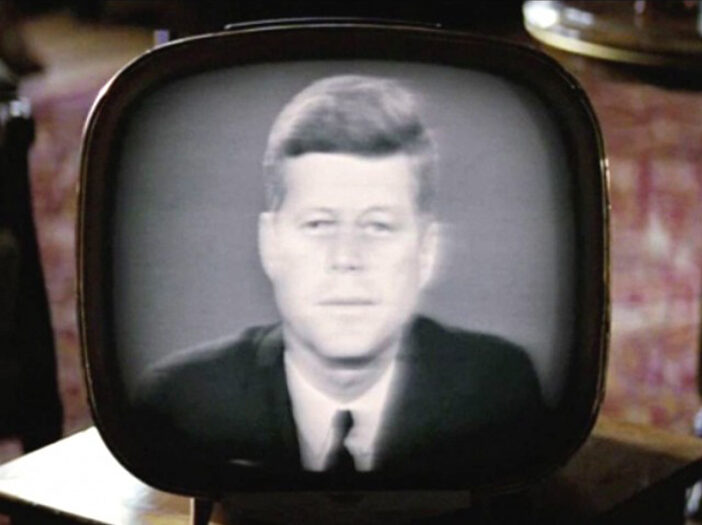
This week in 1962, President John F. Kennedy held a press conference to announce a naval blockade of Cuba due to Russia’s nuclear presence on the island, as well as growing concern over the expansion of Communism into Latin America. During this time, U.S. efforts to overthrow Cuban dictator Fidel Castro, who aligned himself with U.S.S.R. President Nikita Khrushchev and allowed the Soviet military to occupy Cuba, intensified as conflict between the nations escalated. The 13-day confrontation pushed the U.S., the Soviet Union and Cuba to the brink of nuclear war. Ultimately, the conflict was settled on October 28th, as Kennedy and Khrushchev agreed to certain concessions. The Soviets would dismantle and remove their weapons from Cuba, while the U.S. agreed to never invade Cuba and also dismantle their nuclear weapons located in Turkey and Italy. In remembrance of this tumultuous time in the United States’ history, DYR looks back at the President’s moving address and some films it inspired.
President Kennedy Addresses the Nation
Kennedy reveals U.S. plans to blockade Cuba in response to the actions of the Soviet Union.
Cuban Missile Crisis Timeline
[vc_raw_html el_class=”Cuban Missile Crisis Timeline”] JTNDb2JqZWN0JTIwd2lkdGglM0QlMjI2NDAlMjIlMjBoZWlnaHQlM0QlMjI0ODAlMjIlMjBjbGFzc2lkJTNEJTIyY2xzaWQlM0FkMjdjZGI2ZS1hZTZkLTExY2YtOTZiOC00NDQ1NTM1NDAwMDAlMjIlMjBjb2RlYmFzZSUzRCUyMmh0dHAlM0ElMkYlMkZkb3dubG9hZC5tYWNyb21lZGlhLmNvbSUyRnB1YiUyRnNob2Nrd2F2ZSUyRmNhYnMlMkZmbGFzaCUyRnN3Zmxhc2guY2FiJTIzdmVyc2lvbiUzRDYlMkMwJTJDNDAlMkMwJTIyJTNFJTNDcGFyYW0lMjBuYW1lJTNEJTIycGFzc2VkVGltZWxpbmVzJTIyJTIwdmFsdWUlM0QlMjIxMTgyMDQlMjIlMjAlMkYlM0UlM0NwYXJhbSUyMG5hbWUlM0QlMjJhbGxvd1NjcmlwdEFjY2VzcyUyMiUyMHZhbHVlJTNEJTIyYWx3YXlzJTIyJTIwJTJGJTNFJTNDcGFyYW0lMjBuYW1lJTNEJTIyc3JjJTIyJTIwdmFsdWUlM0QlMjJodHRwJTNBJTJGJTJGd3d3LnRpbWV0b2FzdC5jb20lMkZmbGFzaCUyRlRpbWVsaW5lVmlld2VyLnN3ZiUzRnBhc3NlZFRpbWVsaW5lcyUzRDExODIwNCUyMiUyMCUyRiUzRSUzQ3BhcmFtJTIwbmFtZSUzRCUyMnBhc3NlZHRpbWVsaW5lcyUyMiUyMHZhbHVlJTNEJTIyMTE4MjA0JTIyJTIwJTJGJTNFJTNDcGFyYW0lMjBuYW1lJTNEJTIyYWxsb3dzY3JpcHRhY2Nlc3MlMjIlMjB2YWx1ZSUzRCUyMmFsd2F5cyUyMiUyMCUyRiUzRSUzQ2VtYmVkJTIwd2lkdGglM0QlMjI2NDAlMjIlMjBoZWlnaHQlM0QlMjI0ODAlMjIlMjB0eXBlJTNEJTIyYXBwbGljYXRpb24lMkZ4LXNob2Nrd2F2ZS1mbGFzaCUyMiUyMHNyYyUzRCUyMmh0dHAlM0ElMkYlMkZ3d3cudGltZXRvYXN0LmNvbSUyRmZsYXNoJTJGVGltZWxpbmVWaWV3ZXIuc3dmJTNGcGFzc2VkVGltZWxpbmVzJTNEMTE4MjA0JTIyJTIwcGFzc2VkdGltZWxpbmVzJTNEJTIyMTE4MjA0JTIyJTIwYWxsb3dzY3JpcHRhY2Nlc3MlM0QlMjJhbHdheXMlMjIlMjBwYXNzZWR0aW1lbGluZXMlM0QlMjIxMTgyMDQlMjIlMjBhbGxvd3NjcmlwdGFjY2VzcyUzRCUyMmFsd2F5cyUyMiUyMCUyRiUzRSUzQyUyRm9iamVjdCUzRQ== [/vc_raw_html]
Here are some films inspired by the crisis the presidents moving speech.
The Missiles of October (1974)
https://youtu.be/dmtp8XosVBE
Based on Robert F. Kennedy’s book, Thirteen Days, this made-for-television docudrama focused on the Kennedy administration during the Cuban Missile Crisis. It took the public behind the scenes and displayed the political bartering that led to the President’s decision to quarantine instead of invade the island.
Matinee (1993)
A filmmaker capitalizes on the hysteria of the surrounding Cuban Missile Crisis to create an extremely unique theatergoing experience for his Key West, Florida, audience.
Thirteen Days (2000)
In October 1962, surveillance photos taken by a U-2 plane show that the Soviet Union is positioning nuclear weapons around Cuba. President Kennedy must whether to authorize a military strike against Cuba, which could potentially lead to Soviet retaliation against U.S. allies.
